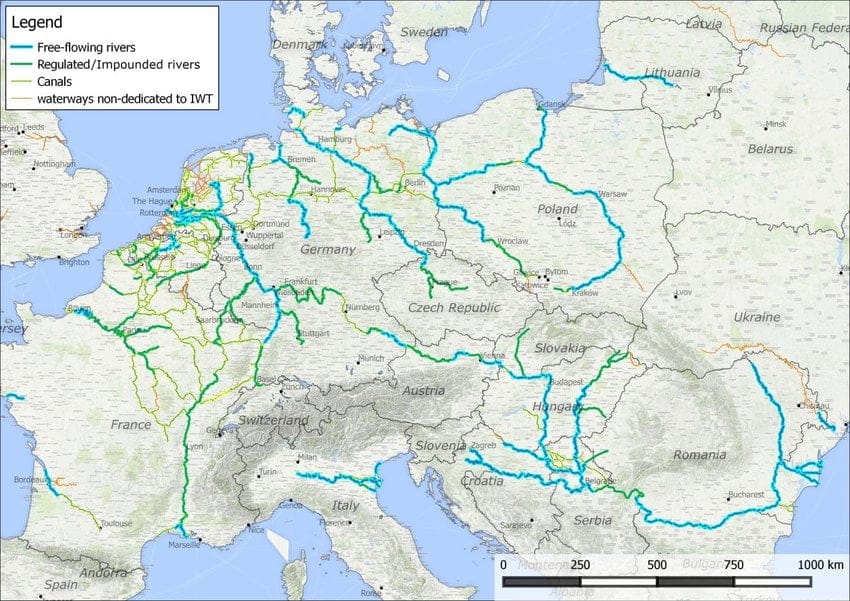Get ready to dive into the heart of Europe’s economic engine! This isn’t just some picturesque river; this is a network of canals, rivers, and ports that has been the backbone of trade and wealth for centuries, stretching across the continent, connecting countries, and fueling economic growth. Let’s explore this watery wonderland and discover how it helped Europe grow and thrive.
What is the most important commercial waterway in Europe?
Imagine a ribbon of water, a bustling waterway acting like a giant, liquid highway, flowing through the very heart of Europe. This is the Rhine, a river that has been instrumental in shaping European trade and commerce for centuries.
What makes the Rhine so special? It’s strategically located, originating in the Swiss Alps and flowing north through major industrial and economic hubs in Switzerland, France, and Germany before emptying into the North Sea in the Netherlands. This central route provides a highly efficient and cost-effective means of transporting goods, from raw materials like coal and steel to finished products like automobiles and food.
The Rhine is like a giant conveyor belt, moving millions of tons of cargo annually. It’s a vital link connecting businesses across Europe and, through the North Sea, to the rest of the world. As such, it plays a crucial role in the European Union’s economic success.
But the Rhine is much more than an industrial corridor. Its banks are adorned with majestic castles, rolling vineyards, and charming towns, each whispering tales of Roman emperors, medieval merchants, and the birth of modern industry. A journey along the Rhine is a journey through time, revealing the rich tapestry of history that makes Europe so unique.
While Europe boasts many rivers, the Rhine stands out as the heavyweight champion of commercial waterways. It is both a powerful force in the European economy and a poignant symbol of the continent’s interconnectedness, its past, and its present.
What is the most important waterway in Europe?
Given the significance of Europe’s waterways, singling out the most important is challenging. However, the mighty Rhine River consistently ranks at the top. Flowing through Switzerland, France, Germany, and the Netherlands, the Rhine connects major industrial zones, facilitating trade between these countries and their neighbors.
The Rhine acts as the main artery of European trade, efficiently transporting essential goods. Its importance is amplified by its connection to an impressive network of rivers, canals, and lakes, which collectively have driven the continent’s economic success.
What further distinguishes the Rhine is its course through the heart of some of Europe’s most powerful economies – Germany, Belgium, and the Netherlands – and its direct link to the North Sea. This access transforms the Rhine from an internal route into a gateway for European goods to reach global markets.
To illustrate the sheer volume of trade the Rhine supports, consider this: in 2021 alone, it transported a staggering 344 million tons of cargo. This incredible feat underscores why experts deem the Rhine River indispensable to European trade and economic stability.
What is the most important commercial river in Europe?
When it comes to commerce, the mighty Rhine again takes center stage. Imagine a river so crucial to European trade that it’s practically the lifeblood of the continent’s economy.
This isn’t just a river meandering through idyllic landscapes; it’s a bustling highway of barges and cargo ships transporting goods between European economic powerhouses like Switzerland, France, Germany, and the Netherlands. This 1,320-kilometer waterway, originating in the Swiss Alps and flowing to the North Sea, serves as a critical artery pumping vital resources across the continent.
The Rhine is the key player in the transportation of a diverse range of goods, including chemicals, coal, steel, and food. Its impact, however, extends far beyond the goods themselves, for the Rhine acts as a liquid handshake between nations, fostering economic growth and cooperation. Without it, European trade would be significantly more complex and likely less prosperous.
The Rhine doesn’t operate in isolation. It’s part of a larger intricate web of waterways—canals, rivers, and lakes—that together comprise a super-efficient network for transporting goods. This synergy is a big part of what makes Europe an economic powerhouse, and at the heart of it all flows the magnificent Rhine.
What is the commercial waterway in Europe?
The short answer? The Rhine River. This mighty waterway has served as Europe’s go-to route for transporting goods for centuries, connecting countries and fostering economic growth. From its source in the Swiss Alps to its mouth at the North Sea, the Rhine flows through some of Europe’s most populated and economically vibrant areas, making it a critical artery for the continent’s economic activity.
But the Rhine is much more than a waterway for cargo ships. It stands as a symbol of European interconnectedness, a testament to the shared history and collaboration that defines modern Europe. A cruise down the Rhine is a crash course in European culture and beauty, passing charming towns, fairytale-like castles, and sprawling vineyards.
While the Rhine may be the star, Europe boasts a robust network of inland waterways—rivers, canals, and lakes—that are all part of a larger, interconnected system. This intricate network has been instrumental in shaping the economies of different regions and fostering trade relationships.
Let’s talk about some other heavy hitters in the European waterway game:
- The Danube: This mighty river is a close contender to the Rhine in terms of commercial significance.
- The Rhone: Another key player in Europe’s intricate water highway system.
Venturing outside of the European Union, Russia takes the crown for sheer size, with over 102,000 kilometers of navigable rivers and canals. It’s safe to say that Russia takes its waterways very seriously!
Why is the Rhine River so Important to Europe?
The Rhine River is to Europe’s economy what an engine is to a car: vital! This isn’t about leisurely boat rides; it’s the primary route for shipping goods from Europe’s heartland to the North Sea and, from there, to the rest of the world. The constant flow of goods on this watery highway is a major reason why European businesses can thrive and easily engage in global trade.
What makes the Rhine even more remarkable is its connection to a network of smaller rivers and canals, creating a massive spider web of water with the Rhine at its center. This interconnectedness allows even small towns and businesses along these tributaries to benefit from the Rhine’s impressive reach.
Beyond its economic significance, the Rhine holds immense historical and cultural value. For centuries, communities have developed along its banks, leaving behind a rich tapestry of stories, architecture, and traditions. The Rhine has witnessed the rise and fall of empires, inspired artists, and continues to connect people and cultures to this day.
Here’s a quick rundown of why the Rhine is so vital:
- Trade: It serves as the backbone of European trade, facilitating the exchange of goods and, as a result, supporting a robust economy.
- Industry: The Rhine’s efficient transportation system supports a variety of industries that depend on it for the movement of raw materials and finished goods.
- History and Culture: The river’s long history is palpable in the numerous cultural landmarks, traditions, and stories connected to it.
But there’s always more to learn!
Though we’ve learned a lot about the Rhine, research is ongoing. Scientists continue to study its ecosystem, historians are unearthing new stories about its past, and economists are analyzing its impact on the modern world. The Rhine River is a powerful reminder that even something as seemingly unchanging as a river is constantly evolving and shaping the world around it.
What is the most important waterway in the world?
Choosing the single most important waterway in the world is a difficult task, but the Rhine River is undoubtedly a top contender due to its impact on trade, industry, and history.
The Rhine functions as a liquid superhighway, flowing through some of Europe’s most important industrial centers. Like the main artery of a bustling city, it connects these centers to the North Sea, opening up global trade routes. This efficient transportation system allows goods, from raw materials to finished products, to move quickly and efficiently throughout Europe and beyond.
The Rhine’s well-developed system of canals and locks enhances its efficiency by helping ships of all sizes navigate natural obstacles with ease. This sophisticated infrastructure streamlines the journey, further boosting economic activity along its route.
From the time of the Roman Empire, the Rhine has played a vital role in shaping European political and cultural landscapes, serving as a border, a battleground, and a source of inspiration for artists. Today, it symbolizes cooperation and economic unity for the countries through which it flows.
The chemical industry, in particular, owes much of its success to the Rhine. The readily available water supply and exceptional transportation network make the river’s banks ideal locations for chemical production.
While definitively crowning one waterway as the “most important” is nearly impossible, the Rhine River presents a compelling case with its unique blend of economic significance, historical weight, and impressive infrastructure. It’s a force of nature that continues to shape the world around it.
What is the strategic waterway in Europe?
The Rhine River is more than just a scenic waterway; it is the lifeblood of the European economy. This vital artery, flowing through the heart of Switzerland, France, Germany, and the Netherlands before reaching the North Sea, is essential for trade and transportation.
The Rhine’s importance to European commerce lies in its ability to efficiently move massive quantities of goods. While trucks and trains have their limitations, the Rhine provides a naturally efficient and cost-effective way to transport raw materials and finished products, fostering economic growth. It’s no surprise that so many industries have developed along its banks.
The Rhine’s significance extends beyond economics. For centuries, it has been a constant presence amidst changing political landscapes and shifting cultural tides. It stands as a symbol of unity, a reminder of the shared history and interconnectedness of the countries it traverses.
Think of it this way:
- The Rhine is like a vital artery in the body of the European economy.
- It’s a natural conveyor belt, seamlessly moving goods from production centers to the sea.
- Without the Rhine, transportation costs would likely rise, potentially impacting consumer prices.
- The river embodies European cooperation and shared history.
- And, let’s not forget, its beauty contributes to the cultural richness of the region.
What are the most important seas in Europe?
Let’s expand our exploration beyond rivers and delve into some of Europe’s most significant seas.
The Mediterranean: More Than Just a Pretty Face
While the Mediterranean Sea beckons with its beauty, this iconic body of water is much more than a vacation destination. In ancient times, it served as a vital highway connecting powerful trading cities like Venice and Genoa with the Middle East, North Africa, and beyond. This maritime route facilitated the exchange of goods, cultures, and ideas. Even today, the Mediterranean remains a superhighway for ships carrying goods all over the world.
The North Sea: Powering Up Northern Europe (Literally)
Nestled between the British Isles and mainland Europe, the North Sea has long been a key player for countries like the UK, the Netherlands, and the Scandinavian nations. Bustling ports like London, Rotterdam, and Hamburg facilitate the movement of goods, connecting Northern Europe with the global market. But the North Sea holds another valuable resource: oil and gas. These energy resources have been a boon to the economies of countries like Norway and the UK.
The Baltic: Bridging the East and West
Further north, the Baltic Sea provides a crucial link between Scandinavian countries, the Baltic States, and Russia. Major cities like St. Petersburg, Stockholm, and Helsinki have all flourished thanks to the robust trade routes of the Baltic. Beyond its economic impact, this sea boasts remarkable biodiversity, supporting a wide range of marine life and coastal habitats.
Don’t Forget These Seas!
Europe’s diverse geography encompasses even more notable seas, each with its own unique story:
- The Black Sea: This sea, nestled between Europe and Asia, has witnessed the rise and fall of empires, shaped by centuries of trade and military maneuvers.
- The Adriatic Sea: This arm of the Mediterranean, shared by Italy, Croatia, and Slovenia, is known for its crystal-clear waters, charming towns, and thriving tourism industry.
- The Aegean Sea: Synonymous with Greek mythology and history, the Aegean Sea, dotted with picturesque islands, is steeped in ancient tales of gods, heroes, and epic adventures.
Europe’s seas are more than just bodies of water. They’re living records of history, drivers of economic growth, and integral to the identity of the continent and its people.
What is the most important canal in Europe?
While the Rhine River is a natural wonder, its success as a trade route is greatly enhanced by the intricate network of canals and locks built alongside it. This ingenious feat of engineering is like a superhighway system for one of Europe’s most impressive rivers.
The Rhine flows through some of Europe’s busiest industrial areas, including those in Switzerland, France, and Germany. Its canal system connects the river to other major waterways, including the North Sea, creating a highly efficient route for moving massive cargo ships laden with goods. Without this network, transporting such quantities of materials would be significantly more difficult and costly, potentially impacting global markets.
The Rhine also offers incredible scenery. Picture yourself drifting down the river, passing idyllic villages, majestic castles, and landscapes straight out of a fairytale. It’s a journey through time, a testament to the rich history of the people who have lived, traded, and fought along its banks for centuries.
Here’s a recap of why the Rhine’s canal system is so vital:
- Trade Superhighway: Connects key industrial zones, making the transportation of goods more efficient and affordable.
- Global Gateway: Links to the North Sea, enabling trade with the rest of the world.
- Industrial Lifeline: Essential for industries like chemical production, which depend on the Rhine to transport both raw materials and finished products.
- Historical Gem: Offers a captivating journey through time, showcasing stunning landmarks and revealing stories of Europe’s vibrant past.
While not a canal in the traditional sense, the Rhine, when combined with its remarkable canal system, is arguably the most important waterway in Europe. It’s a testament to human ingenuity and a vital artery that keeps the heart of Europe beating strong!
What is the major waterway of Central Europe?
In Central Europe, one river reigns supreme: the Rhine. This isn’t merely a scenic waterway; it is the backbone of the region’s economy, a liquid highway facilitating the constant flow of goods between countries like Switzerland, France, Germany, and the Netherlands. The Rhine’s ability to efficiently move products is a key reason for the economic success of these nations.
But the Rhine is more than just an economic engine. It is also an ecological wonder, supporting diverse flora and fauna, and its presence has shaped the culture and history of Central Europe in profound ways. The Rhine exemplifies the delicate balance between human progress and environmental preservation.
Okay, let’s break it down:
- The Rhine River is the undisputed champion of commercial waterways in Central Europe.
- It seamlessly connects major industrial areas, facilitating trade between countries.
- It’s a river with a rich history of economic and cultural influence.
- The Rhine is both a haven for biodiversity and a treasure trove of cultural heritage.
What is the most famous waterway?
The Rhine River often tops the list of Europe’s most iconic waterways. Flowing over 1,230 kilometers, it connects the North Sea to the heart of Europe, passing through bustling cities, picturesque farmlands, and breathtaking mountains. The Rhine is a testament to the power of nature and the enduring impact of human history.
Since the time of the Roman Empire, when it served as a critical trade route, the Rhine has played a pivotal role in shaping European history. It was an essential artery for the Hanseatic League, a powerful group of medieval traders, and it continues to drive economic growth today, transporting vast quantities of goods between Switzerland, France, Germany, and the Netherlands.
The Rhine’s significance extends far beyond its role as a waterway for goods. It stands as a symbol of European unity and collaboration, connecting diverse cultures and landscapes. Its beauty has captivated artists, writers, and musicians for centuries, solidifying its place in Europe’s rich cultural tapestry.
Some experts suggest that the Rhine played a crucial role in early human migration and settlement patterns in Europe. Archaeological finds along its banks continue to reveal clues about prehistoric trade routes and cultural interactions, highlighting the river’s significance throughout human history.
It’s important to note that the concept of “most famous” is subjective. While the Rhine holds a prominent position, other European waterways, such as the Danube and the Volga, also hold immense historical and cultural significance.
In a nutshell:
- The Rhine is a European icon, renowned for its beauty and historical importance.
- It boasts a rich history as a trade route and continues to play a vital role in European commerce.
- As a connector of countries and cultures, the Rhine symbolizes European unity.
- Its stunning scenery has inspired countless artists, securing its place in the European identity.
- While the Rhine often claims the title of most famous, other European rivers, such as the Danube and Volga, have their own captivating stories.
Eager to learn more? Dive into the fascinating world of European waterways! There’s always something new to discover.
What are some other important rivers in Europe?
While the Rhine might be the star of the show, Europe is home to a network of impressive rivers, each contributing to the continent’s rich history, culture, and economy. Here are a few notable mentions:
- Danube: Flowing from Germany to the Black Sea, the Danube is the second-longest river in Europe and a vital waterway for central and southeastern Europe. It connects important cities like Vienna, Budapest, and Belgrade and has played a significant role in trade and cultural exchange for centuries.
- Elbe: This German river flows from the Czech Republic to the North Sea, passing through Hamburg, one of Europe’s largest ports. The Elbe has been a crucial trade route since the Middle Ages and continues to be important for transporting goods to and from inland areas.
If you are fascinated by the beauty of the river and its neighboring countries, you must know which countries the stunning Rhine river flows through. You will be mesmerized by the picturesque views along the banks of the river and the rich history associated with it.
The Elbe has been one of the most popular rivers in Germany, and it’s rich in culture and history. If you are curious about whether or not you can swim in this river, you must check out this informative article. You will be amazed to know the amazing facts about Elbe and the detailed information about swimming in this river.
These rivers, along with countless other waterways, highlight the interconnectedness of Europe and the importance of these natural highways in shaping the continent’s identity and prosperity.
- Unlocking Francis Alexander Shields’ Finance Empire: A Comprehensive Biography - July 12, 2025
- Unveiling Francis Alexander Shields: A Business Legacy - July 12, 2025
- Francis Alexander Shields’ Business Career: A Comprehensive Overview - July 12, 2025















